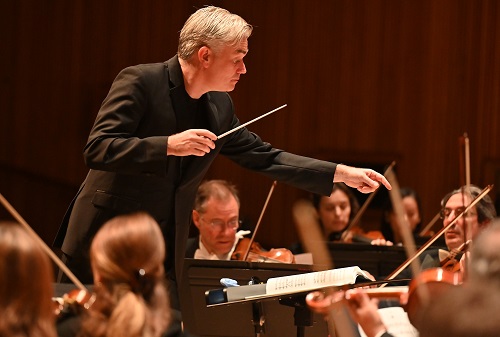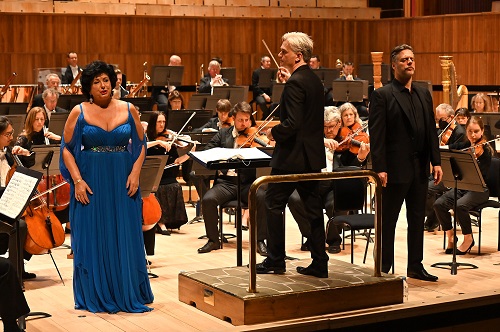In 1911, 30-year-old Béla Bartók began work on an instructive edition of seventeen of Haydn’s Piano Sonatas. Between February and September that year, he also composed his first and only opera, Duke Bluebeard’s Castle, though he revisited and revised that score in 1912 and again in 1817, adding a new ending, before the opera received its first performance on 24th May 1918 at the Royal Hungarian Opera House in Budapest.
Bartók’s hour-long expressionist opera, with a libretto by Béla Balázs based loosely on a comte by Charles Perrault, is more frequently encountered in the concert hall than on the opera stage. Perhaps that’s because it’s a challenge to select an appropriate work to complete a programme alongside an opera which Zoltan Kodály described as ‘a musical volcano erupting for sixty minutes of tragic intensity’? Puccini’s Gianni Schicchi, Tchaikovsky’s Iolanthe, Schoenberg’s Erwartung, Stravinsky’s Le Rossignol andWolf-Ferrari’s Il Segretto di Susanna are some of the one-acters that have done service. New operas have been composed for the purpose, such as Peter Eötvö’s Senza Sangu (2016) and The 8th Door, conceivedby director Matthew Lenton and composed by Lliam Paterson for Scottish Opera in 2017. In 2014, Los Angeles Opera selected Purcell’s Dido and Aeneas to form a daring double bill of two operas about a man and a woman, arrival and departure.
In 2015, Charles Dutoit and the Royal Philharmonic Orchestra preceded the opera with Hector Berlioz’s ‘Rakoczi March’ from The Damnation of Faust and Franz Liszt’s Piano Concerto No.2. At the Proms the following year, they placed Bluebeard’s darkness after the soulful warmth of Dvořák’s Cello Concerto. On both occasions the role of Judith was sung by mezzo-soprano Ildikó Komlósi and on the latter she was joined by bass John Relyea. Both are veterans in the roles of the naïve but wilful Judith and the reserved, elusive Bluebeard, and the duo came together again for this performance by the London Symphony Orchestra under their Principal Conductor, Edward Gardner, at the Royal Festival Hall.
Gardner chose to begin the evening with Joseph Haydn’s Symphony No.90 – an example of ‘Papa Haydn’ in his most joyful, tuneful C-major mode, and a work whose last movement ‘requires’ some participation from a misled audience to bring its good-natured musical mischievousness to fruition. This was certainly thought-provoking programming. I doubt that Gardner was expecting his listeners to perceive any connections between Bartók’s ‘classicism’ and Haydn – the motivic development, the use of false recapitulations – such as might keep musicologists occupied, the much more obvious link between the two works being one of tonality. For, the key of Haydn’s C-major Symphony foreshadows the glorious deluge of potent light which issues from the fifth door of Bluebeard’s castle, representing the majesty and expanse of his dominions.

And, one of the most striking aspects of this superb performance was the sculpting of the arc from the initial dark shadows of mystery to that radiant glow of pride and power, and through the subsequent withdrawal into a black abyss. On the concert platform, it is the orchestra – as the doors of Bluebeard’s Castle are opened one by one – that must bear the responsibility for transforming Bartók’s musical depiction into an engulfing, theatrical experience. The ‘drama’ is metaphorical, internal. In this regard, Gardner’s pacing and precision were masterful, the inexorable progress of the psychological drama both mesmerisingly controlled and expressively pliant. The LPO were on simply stunning form.
In some ways, the tone and timbre were quite Romantic, the musical ‘edges’ smoother than we might expect. There was an impressionistic lushness when the fourth door was opened revealing the garden sparkling with flowers and gems. But, Gardner conjured the tang of something macabre when Judith noticed that the petals were covered in blood, the symbolic roses as cankered as Baudelaire’s fleurs du mal. The apocalypse of sound which greeted the opening of the fifth door was shattering, but Gardner did not wallow in the blaze of organ and brass, pushing forward and thus enhancing the contrast with the still, haunting bleakness of the Lake of Tears. And, the tense ambiguity before the seventh door was opened was nervy and discomforting, as it should be.
Komlósi’s Judith began with eager brightness, invigorated by love for her new husband, excited by the fresh possibilities that lay before her, confident that she could assuage the castle’s pain. Wilful, persistent she would not relinquish her desires, and these became a self-destructive and inescapable compulsion – as if to withdraw her demands and questions would be to diminish her ‘self’, her heroism thus a futile buttress against inevitable, self-driven annihilation. Accordingly, Komlósi’s voice acquired darker hues, but was no less stubborn or sure. The Hungarian mezzo-soprano has a Wagnerian power that, while its full heft did not need to be repeatedly employed, allowed her to sing above the full orchestral sound without undue strain, retaining tonal beauty. Not once did the voice falter. And, I felt that she sang with less vibrato than on the previous occasions I have heard her sing the role. The result was to strengthen our sense of Judith’s steely relentlessness and tragic doom.

From the first, John Relyea’s Bluebeard, for all his self-command and poise, seemed terribly alone, the darkness in his bass a presentiment of eternal alienation. He shaped the parlando rubato as naturally as the Hungarian Komlósi, singing in her native tongue. Bluebeard’s bombastic aggrandising when displaying the full range and richness of his kingdom was noble and almost irresistibly assured, but was followed by vulnerability, when Judith persisted in her demands that the final doors be opened. The subsequent revelation of despair that such disclosure has precipitated the inevitable loss of Judith was heartrending. Indeed, one might feel that Relyea garnered almost too much sympathy for the blue-bearded Duke of dark corners. When, in the final moments, he crowned Judith with the mantle and jewels that are all that will accompany her into the eternal void that awaits her, his solemnity was unbearably tragic. Now we, like Judith, knew what Bluebeard had known all along: that the further one reaches into another’s soul, the more impossible it is to know that soul. After all, ‘My castle shall not gleam’, he has foretold.
The performance had begun with a disembodied voice, its grave, amplified words carrying the opera’s spoken prologue to the far reaches of the Festival Hall. At the close there was a corresponding withdrawal into an otherworld, as the final door closed and Bluebeard was left alone in the darkness, his love physically and symbolically entombed.
So, what of the Classical preface afforded by Haydn’s 90th Symphony? Certainly, Gardner conjured the bright joviality of the opening Allegro assai, which got underway with light feet once the rhetoric of the introductory Adagio had resounded with C-major confidence. Gardner’s economic style and unfussy attention to detail, the elasticity of the syncopations and hemiolas, the violins’ feather-light staccatos and scales that slithered with the precision of an ice-dancer, the dulcet colours of the woodwinds’ second subject – all was sunny and cheerful. The Andante, introduced by a lovely warm bassoon melody,had the intimacy of an opera aria, and while there were telling contrasts between the major- and minor-key episodes of the variation form, there was an easy sway to the exchange of moods, too. If, here, the concertante textures suggested that the fiddles were dancing on air, then the Menuetto was sturdier but still gracious, horns and high trumpet reinforcing the C-major tonality with stately vigour before the Finale romped home – brisk but not harum-scarum, though the double basses were required to sprint with impressive athleticism up and down the fingerboard in the strings’ climactic unison scales at the end of the extended recapitulation.
This movement sees Haydn indulge his crafty musical humour, and his deviousness caught out the audience – as surely it must for the silence in the score which follows the false ending, or rather double false endings, to make sense. For just when it seems that the sunny uplands have been reached, Haydn plays the trick up his sleeve, reprising the material of the main theme up a semitone in the key of Db, and then repeating the joke before the coda brings the music safely home. Gardner carried off Haydn’s deviousness with unassuming charm. Perhaps Haydn is telling us that there’s always another door to open?
Claire Seymour
Ildikó Komlósi (mezzo-soprano), John Relyea (bass), London Symphony Orchestra, Edward Gardner (conductor)
Haydn – Symphony No.90 in C Major Hob. I:90, Bartók – Bluebeard’s Castle
Royal Festival Hall, London; Saturday 6th November 2021.
ABOVE: London Philharmonic Orchestra, Edward Gardner, Ildikó Komlósi and John Relyea (c) Mark Allan